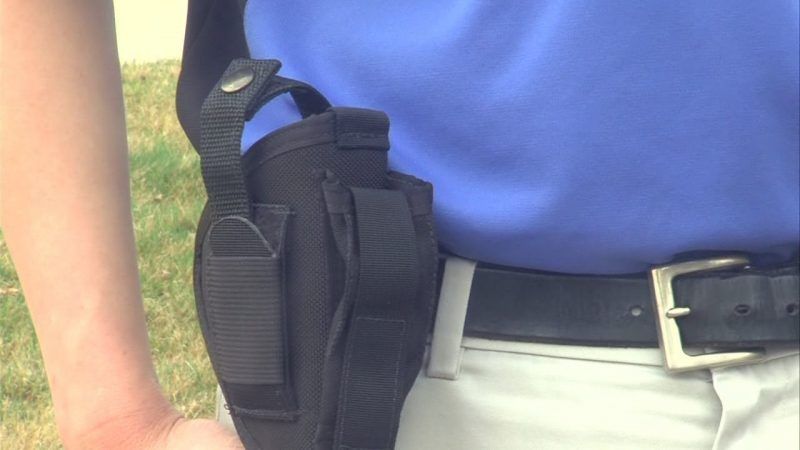Do These 21 Mass Shootings That Did Not Happen Show the Benefits of California's 'Red Flag' Law?
Only if you assume they would have happened in the absence of gun confiscation orders.

A new study of California's "red flag" law describes 21 cases in which fear of a mass shooting prompted police or relatives to seek "gun violence restraining orders" (GVROs) from 2016 (when the law took effect) through 2018. Judging from "print, broadcast, and Internet media searches using Google," the authors say, the respondents in those cases did not subsequently commit any noteworthy violent crimes.
"It is impossible to know whether violence would have occurred had GVROs not been issued, and we make no claim of a causal relationship," write University of California, Davis, gun violence researcher Garen Wintemute and his co-authors in the Annals of Internal Medicine. "Nonetheless, the cases suggest that this urgent, individualized intervention can play a role in efforts to prevent mass shootings."
Wintemute et al. say GVROs were sought in 414 cases during the three years covered by their study. The New York Times reports that San Diego City Attorney Mara Elliott "has obtained about 300 orders in the past two years,"which implies that one city accounts for something like three-quarters of GVROs.
So far Wintemute et al. have been able to obtain court records for only 159 GVRO cases, of which 21, or 13 percent, involved attempts to prevent mass shootings. "The cases are not taken from the full population of 414 and may not be representative of all GVROs involving threatened mass shootings," they note. "The seemingly high proportion of threatened mass shootings among GVRO cases (13% in this study) may also not be representative."
Of the 21 cases identified by Wintemute et al., seven involved threats of violence at work, five involved the targeting of children or schools, four involved "a medical or mental health condition," and five involved a "political, social, or domestic motivation." By and large, the warning signs described in the study seem legitimately alarming, although it is not clear how many of the threats were serious or how determined the respondents were to carry them out.
At one extreme, for example, there is a "31-year-old man who was known in his Muslim community as a supporter of the Islamic State," who was "on the Terrorist Screening Center Watchlist," who "made repeated threats of mass violence," and who had recently purchased an FN Five-seven semi-automatic pistol. A GVRO prevented him from picking up the gun after California's 10-day waiting period.
At the other extreme, perhaps, is the 14-year-old high school student "with a history of racist comments at school" who posted "videos on Instagram of himself using firearms, favorable comments about school violence and shootings, racist comments, and suggestions of animal cruelty." After he was taken into custody for a psychiatric screening, he "claimed that he had been joking." Police nevertheless seized his father's guns.
There is also the 62-year-old woman who menaced five kids with "a paper towel roll wrapped in black duct tape," threatening to "blow their heads off." Police confiscated her (real) revolver, which she kept in her living room, and obtained a GVRO barring her from possessing guns for a year.
In between, maybe, are several people with work-related grudges whose threats may or may not have been in earnest. The week before he was fired by a car dealership, for example, a 65-year-old veteran came to work wearing an empty holster "to frighten the manager." When police officers asked whether there was any reason to worry that he might hurt his former co-workers, he replied, "If we were back on the border of Syria and Israel, then hell [yeah]." A judge issued a one-year GVRO against him.
Since none of these people (even the more serious-sounding ones) appear to have obtained guns by indirect means after they were barred from legally buying or possessing them, it seems fair to say they were not highly motivated. Then again, that is the only sort of would-be mass murderer who could be stymied by a red flag law.
As Wintemute et al. note, a fuller picture of what California's red flag law is doing would emerge from an examination of all the GVROs issued so far, rather than a subsample of a subsample. Contrary to the impression left by these 21 cases, the experiences of other states suggests that gun confiscation orders are usually aimed at preventing suicide rather than homicide. And even when a respondent is deemed a threat to others, the evidentiary burden on the government may be pretty light in practice.
Under California's law, an initial, ex parte GVRO lasting up to three weeks can be issued based either on "reasonable cause" to believe the respondent poses an "immediate and present danger" to himself or others, or on a "substantial likelihood" that the respondent poses a "significant danger" in the "near future." After a hearing, a GVRO lasting up to year (unless it's renewed) can be issued based on "clear and convincing evidence" that the respondent poses a "significant danger." The danger need not be imminent, and it's not clear what "significant" means.
To get a better idea of how those standards work in practice, it would be helpful to know how often initial orders are issued (almost always, I'd guess, based on the experience in Maryland and Florida) and how often they are followed by final orders (also almost always, judging from the sample described by this study, which may not be representative in that regard). These 21 cases give us a sense of the harm that California's red flag law might prevent, although that benefit is based entirely on counterfactual speculation, as Wintemute et al. concede. For a sense of the harm that the law causes (by unjustly suspending the Second Amendment rights of people who pose no real threat to others), we would need a broader look at the people it affects.


Show Comments (47)